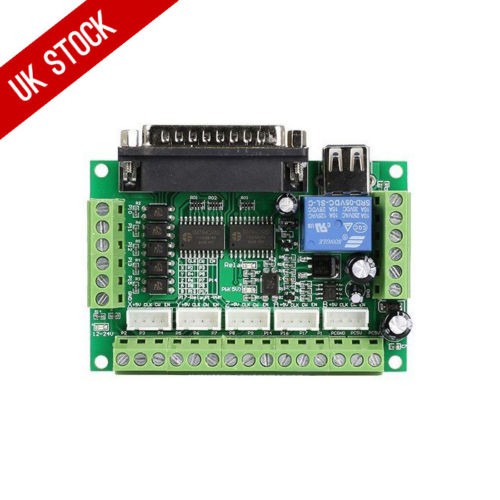Components Needed
- PC to interpret G-Code and provide control signals to stepper motor drivers
- Interface board from PC to stepper motor drivers
- Stepper motor drivers
- Stepper motors
- PSU for stepper motors
I will explain a little about the options I considered for each, and what design decision I reached for each one.
- PC - >Like most hackspaces, Makerspace is well-supplied in older PCs, and a suitable Dell PC with a 'real' parallel port was easily found, This is important because a traditional (ie not USB->parallel port emulator) parallel port allows, with the use of real-time Linux kernel patches, precision control of stepper motor timings and pulse frequencies. The PC was installed with Linux-CNC, which is a Ubuntu distribution with preinstalled E3 CNC software and real-time kernel patches to ensure accurate timing and control. E3 is open source CNC software which 'reads' G-Code, and generates, via the parallel port, the signals needed to move the motors. Project website: Linux-CNC Project
- Interface board. You don't have to have one of these, but it is generally considered good form to provide opto-isolation between the parallel port pins and the stepper drivers/other electronics. I sourced a '5 axis MACH3 CNC Breakout Board for Stepper Drivers" ' from eBay - it is a fairly generic Chinese clone board, and provides the following features:
- Opto-isolated interfacing with 5 stepper motor controllers (X,Y,Z,A,B)
- A relay for controlling an external device (eg coolant pump)
- A 0-10V signal for feeding a 3-phase motor for spindle speed control (adjustable)
- Interfacing for limit switches/encoders etc
![]()
- Stepper motor drivers - your choice here depends on your choice of steppers. I tried some Linistepper drivers I had to hand but even with adequate heatsinking they weren't able to handle to power needed to drive my motors. Therefore, I bought a set of 3 M542 stepper drivers. These are nice and modular, and already have appropriate heatsinking. They have screw terminals for both motor coils, DC+/GND in, and connections for PULSE, DIR and ENABLE signals from the interface board above. I plan to add a fourth, for a dividing head or similar later on, to enable cutting of gears and other things requiring rotating the workpiece. The M542 drivers are rated for up to 50VDC supply voltage, current up to 4.5A, pulse freq to 300KHz, optoisolated imputs, and able to do a microstepping.
![]()
- Stepper motors - I ended up with 3 NEMA-24 8-wire motors, rated at 4NM of torque (in bipolar mode), and requiring 3A current)
![]()
- Power supply - again, after more eBay shopping, I selected a brandless power supply, rated at 36V (600W), and easily capable of driving all the motors/ancillaries I needed.
![]()
 David Pye
David Pye



Discussions
Become a Hackaday.io Member
Create an account to leave a comment. Already have an account? Log In.